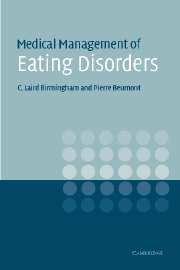Book contents
- Frontmatter
- Contents
- List of color plates
- List of contributors
- List of abbreviations
- Introduction
- PART I THE MEDICAL PERSPECTIVE
- 1 Definitions and epidemiology
- 2 The behavioral disorders
- 3 History, examination, and investigations
- 4 Medical manifestations by system
- 5 The clinician's response to common physical complaints
- PART II TREATMENT
- PART III SPECIAL ISSUES
- PART IV THE PSYCHIATRIC AND PSYCHOLOGICAL PERSPECTIVE
- PART V AREAS OF SPECIAL INTEREST
- Bibliography
- Index
- Plate section
4 - Medical manifestations by system
Published online by Cambridge University Press: 18 December 2009
- Frontmatter
- Contents
- List of color plates
- List of contributors
- List of abbreviations
- Introduction
- PART I THE MEDICAL PERSPECTIVE
- 1 Definitions and epidemiology
- 2 The behavioral disorders
- 3 History, examination, and investigations
- 4 Medical manifestations by system
- 5 The clinician's response to common physical complaints
- PART II TREATMENT
- PART III SPECIAL ISSUES
- PART IV THE PSYCHIATRIC AND PSYCHOLOGICAL PERSPECTIVE
- PART V AREAS OF SPECIAL INTEREST
- Bibliography
- Index
- Plate section
Summary
The medical symptoms and signs of AN and, although less serious, of other eating disorders are part of the illness, and hence it is more appropriate to think of them as medical manifestations rather than merely complications. Although the disorder usually starts in adolescence, its course is often prolonged; AN patients may be ill for many years, and the majority of severely ill AN patients are in early or mid adult life. Hence, AN is a matter of concern for adult physicians as well as for pediatricians and adolescent medicine specialists. Figure 4.1 shows a mnemonic that is useful for remembering the physical signs of eating disorders.
Manifestations result from starvation or from the behaviors adopted to induce it. They are not indicative of underlying pathology. The inexperienced clinician who undertakes unnecessary investigations to exclude all possible causes for each abnormal finding is doing the patient a disservice by delaying appropriate treatment. Rather, all clinicians should be aware of the wide range of physical abnormalities that are commonly found in anorexic patients (Table 4.1). Many of these abnormalities, such as decreased serum concentrations of gonadotropins and steroid sex hormones, alterations to the peripheral metabolism of thyroid hormone, and raised circulating concentrations of cortisol and growth hormone, are best regarded as physiological adaptations to the state of starvation and do not require treatment. However, some medical complications are not only clinically important but are also life-threatening; these require special attention.
- Type
- Chapter
- Information
- Medical Management of Eating DisordersA Practical Handbook for Healthcare Professionals, pp. 48 - 85Publisher: Cambridge University PressPrint publication year: 2004



